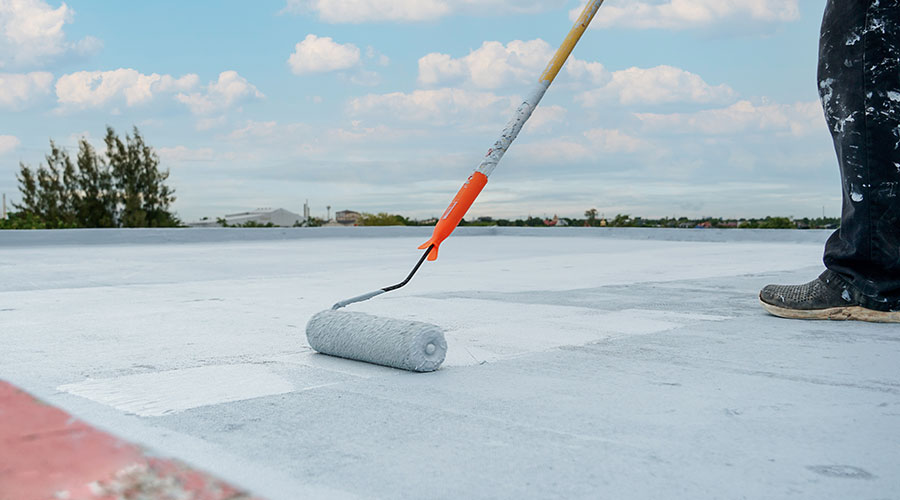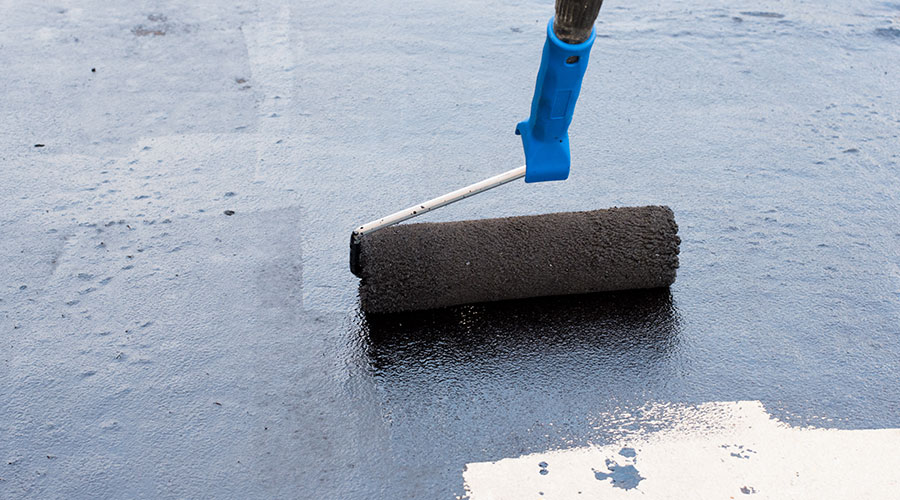Roof Maintenance: Top-Level Priority
Systematic preventive maintenance protects buildings and operations and ensures long-term system performance
Regardless of how well a roof system is designed, roof maintenance always will be a top priority for maintenance and engineering managers. A roof system’s designer can design out many, but not all, high-maintenance issues. A comprehensive preventive maintenance (PM) program can help managers.
By systematically repairing or replacing roofing system components, regardless of the roof system’s current operational condition, managers can address relatively minor roofing system problems before they become larger and more expensive.
Designing Out Maintenance Problems
When designing a roof system, a designer should be aware of the typical maintenance issues of that type of roof system. All roofs — whether built-up, modified bitumen, single ply, or metal — share certain design characteristics that designers and managers must consider:
Drainage. Positive slope — at least 1⁄4 inch per foot based on building code requirement — is necessary to reduce the chance of ponding. Buildings with a slope of less than 2 percent, or 1⁄4 inch per foot, had a 58 percent leak rate. That figure compares with an 11 percent leak rate for roofs sloped at 2 percent or greater, according to a study by consultant Donald J. Smith in The Manual of Low-Slope Roof Systems. If a roof is designed flat, managers can install tapered insulation using saddles, crickets and sumps to minimize ponding water.
Caulking. The use of caulks and sealants can protect roofs and interior operations as roof materials dry, crack and split over time. Although it is highly unlikely that one could get away without using caulk, there are ways to minimize its use. Using reglet mounted counterflashings or wrapping curbs or walls with base flashings can reduce the amount of caulk required. Surface-mounted counterflashings rely on a bead of sealant at the top horizontal edge. Reglet counterflashings use the groove to secure and seal the top of counterflashings.
Sheet metal. Sheet metal plays a central role in a roof system. Managers should be sure that workers use a gauge or thickness and type of sheet metal that can withstand the rigors of chemical, physical and environmental stresses surrounding the roof. The higher cost to upgrade the sheet metal — i.e., stainless steel versus galvanized steel — is minimal, compared to maintenance costs that accrue over the life of the roof using low-quality materials.
Fasteners. Using the proper fasteners can reduce maintenance. When fastening roof-related sheet metal — including counterflashings, copings and gravel stops — it is best to use neoprene, washered, threaded, screw-type fasteners on vertical surfaces. These types of fasteners reduce fastener backout and the need for caulk.
Roof penetrations. Managers can try to change the proximity of roof penetrations to avoid using pitch pockets, which can require filler that over time shrinks and cracks, becoming a maintenance headache. Most warranties also require that curb and counterflashing heights be designed to an 8-inch minimum. The closer the penetration or counterflashing is to a roof surface, the greater the chance of water backing up into the flashings and leaking into the building.
Walkways. Continual rooftop traffic patterns cause erosion of the surface and accelerated deterioration of the system. If managers point out these patterns during design, designers can take precautions and walkways or additional surfacing can be specified and installed in high-traffic areas to protect the membrane and underlying components.
Aggregate ballast or surfacing. Built-up and single-ply roofs require aggregate ballast or surfacing. Although the reasons for using these two roof types differ, this aggregate covering adds weight to the roof and hides the field membrane from view. Covering the roof surface makes it difficult to locate and repair problems.
Defining PM
Since roofs normally must be replaced several times during the life of a building, it only makes sense that the main objective should be to maximize the service life of each new system. To maximize a roof’s service life, managers need to develop and implement a comprehensive PM program. The program should not only be implemented during the design phase and extend through the installation of a new roof system.
All roofs require periodic inspection and maintenance to provide the intended service life. What better time to start this program than when the roof system is new?
A planned PM program includes scheduled inspections that identify problems, as well as the appropriate corrective actions to extend the life of the roof. The frequency of these tasks depends on several factors, including but not limited to environmental influences, rooftop traffic, occupancy sensitivity, and the size and accessibility of the roof.
Managers should schedule roof inspections at least twice a year, typically during spring and fall. A spring inspection enables inspectors to observation any winter damage and to perform required repairs during favorable weather conditions. A fall inspection allows identification and repair of deficiencies before the onset of winter weather. It is also a good idea to perform roof inspections after major storms or construction projects.
Roofing is one of few industries that provide building owners with warranties as long as 20 years. Because of the length and liability extended by a manufacturer’s warranty, many exclusions and covenants apply. Every roofing warranty contains an exclusion stating that if PM is not performed, the warranty is null and void. Warranties usually provide managers and owners with a false sense of security more than a source of protection. Due to this exclusion, maintenance programs aren’t only encouraged but necessary.
Savings and Costs
Many factors come into play when determining the savings generated by implementing a PM program. Studies show that organizations can realize savings of up to 10 percent of a roof’s initial cost by using a proactive approach to PM. One scenario demonstrates that with proper PM, a roof with a 20-year design life can provide another 5-10 years of service life.
Organizations also can realize additional savings if leakage caused by a prematurely failing roof system lead to building damage, product damage or downtime.
The cost to establish a roof PM program depends on several factors, including the type of facility, the size of the roof area, and the complexity of the maintenance issues.
The key to a successful program is the repair and maintenance of small, minor and inexpensive defects before they become major problems that could eventually lead to premature failure and higher costs.
A mentor of mine characterized the role of roof system PM this way: “There is another aspect of roof management that is equally critical to the success of a comprehensive roof management program. In our opinion, 20 years or more of service life becomes a reasonable expectation only when the commitment is made by the owner to properly care for a roof through timely repairs and sustained preventive maintenance.”
Inspection Issues
To implement a preventive maintenance (PM) program, maintenance managers must determine who will perform the required duties. The person or persons chosen should be knowledgeable in roofing and familiar with the type of roof system or systems that must be maintained.
Knowledgeable persons who are familiar with the applicable roof system type should perform inspections. This could include properly trained or educated in-house personnel, a licensed roofing contactor, or a roof consultant. Managers can incur an added cost if either of the latter performs the inspection. But if in-house personnel are not familiar with roofing, than managers should bring in a properly trained individual.
In-house personnel, even if untrained in standard roofing practices, can perform housekeeping inspections. These monthly inspections keep the rooftop and drainage devices clear of debris, including vegetation, construction materials, and obsolete equipment.
These inspections also offer a good opportunity to identify potential damaging conditions. Managers might need to increase the inspection frequency at certain times of the year. For example, during the fall, it might be necessary to inspect the roof weekly to remove vegetation.
If a manager determines that in-house personnel should maintain the roofs, they should be properly educated or trained in standard roofing practices. A manager could train a person — most likely someone with construction knowledge — by sending him or her to a roofing class or seminar that teaches roof inspection, diagnosis and repair. Even if properly trained, however, this in-house person likely would be limited to making small, temporary repairs but deferring permanent and larger repairs to a qualified contractor.
If in-house personnel are not an option, managers should bring in roofing professionals to perform scheduled inspections and provide documentation. The documentation typically consists of a written report, photographs, and notations on a roof plan indicating conditions observed and recommended repairs. The recommendations would then be turned over to a qualified roofing contractor, preferably the installing contractor, for repairs to be made.
Finally, managers must keep accurate records for inspectors to refer to. Managers should keep historical files, including records pertaining to a particular roof area, in a central location to permit easy access and updating. Managers also should keep a logbook that includes dates, times and names of all individuals with roof access.
|
Curt Hallman is a consultant with Benchmark Inc. a national roofing management and consulting firm in Cedar Rapids, Iowa.
Related Topics:











